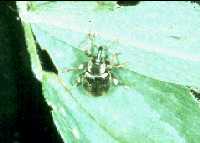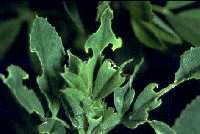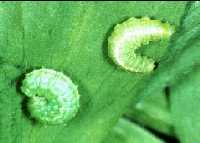by K.K. Kinney and F.B. Peairs * (5/11)
Quick Facts…
- The alfalfa weevil is the most important insect pest of alfalfa in Colorado.
- The use of resistant varieties and timing of cutting can help manage moderate weevil problems.
- Beneficial insects and diseases can combine with good crop management practices to minimize the need for chemical controls.
- Insecticide treatments should be used only when justified by the presence of economically significant numbers of alfalfa weevils.
- Alfalfa weevil insecticide treatments can be very hazardous to honey bees in Colorado.
 |
Figure 1. Adult weevil. |
 |
Figure 2: Ragged leaf damage. |
A number of insect pests attack alfalfa in Colorado. One of the most important is the alfalfa weevil (Hypera postica), which has been a problem in most alfalfa-producing areas of the state since the early 1900s. Losses from this insect vary from year to year, but in some seasons they can be large enough to justify the application of an insecticide.
The key to economical management of the alfalfa weevil is combining crop management practices, biological control and the use of insecticides only when weevil numbers are high enough to ensure that yield benefits outweigh treatment costs.
Life History
The alfalfa weevil spends the winter as an adult in the crowns of the alfalfa plant or under leaves or other debris. Adult weevils are small, 1/4-inch, brownish-grey snout beetles, with a darker brown band down the back.
Another weevil that can be confused with the alfalfa weevil is the clover root curculio or Sitona weevil. These are slightly smaller than the alfalfa weevil and lack the brown band down the back. Sitona larvae feed on roots and occasionally cause serious stand losses in older fields. There are no effective controls for Sitona.
Alfalfa weevil adults emerge in the spring after average temperatures reach 60 degrees F. They start chewing holes in young alfalfa leaves as soon as crop growth begins but do not lay eggs for several weeks. In early April, the female weevils begin to chew holes in alfalfa stems with their beaks. They deposit one to 40 eggs in each cavity. The eggs are small and bright yellow, although they darken as they near maturity.
Egg hatch occurs in one to two weeks. The newly-hatched, yellowish-green larvae (immature weevil or “worm”) feed within the stem for a few days before moving to the opening leaf buds at the tips of the stems. Later, they feed on the leaves, producing a characteristic ragged or skeletonized appearance. Severe damage gives the field a grayish or whitish cast, as if it had been frosted. At maturity, the larvae are dark green, 3/8-inch long, with a black head and a white stripe down the back.
 |
Figure 3: Mature larvae. |
Larvae usually can be found in the field for one to two months, mostly during May and June. Mature larvae move down the plant or drop to the ground and spin a fragile, lacelike cocoon attached to debris or the plant. A new adult emerges after 10 to 12 days. Adults can be found in the field until early fall, when they move to their overwintering sites.
Crop Management Practices
Any crop management practice that helps produce a dense, uniform stand will make the crop better able to tolerate insect feeding. The use of resistant varieties and timing of cutting can help reduce weevil problems. Varieties rated as weevil-tolerant varieties such as Perry and Arc will still produce good yields even after a moderate amount of weevil damage.
Immediate cutting can be an alternative to insecticide application if an economic infestation develops during the bud or early bloom stage. If the cutting cannot be made within the week, then the insecticide treatment should probably be made. Cutting before the optimum gowth stage can reduce dry matter yields, although hay quality may be increased.
Many larvae are destroyed by the cutting process, and others are left exposed to their natural enemies, high temperatures, direct sunlight and lack of food. Survival in stubble can be reduced by removing windrows and bales quickly, as these provide some protection for the larvae. Green-chopping alfalfa is also an effective way to reduce alfalfa weevil populations.
Biological Control
Several natural enemies of the alfalfa weevil have been imported and established in Colorado by the Colorado Department of Agriculture, and new species continually are being imported and released. The small Bathyplectes wasps appear to be well established in several parts of the state and have been reported to parasitize and kill as many as 30 to 35 percent of the larvae in certain fields. Tetrastichus incertus wasps also have been established in many parts of Colorado.
Other beneficial insects such as lady beetles, lacewings and damsel bugs attack some alfalfa weevil larvae and other insect pests of alfalfa. In addition, a fungus disease has been reported, although not in Colorado, to kill large numbers of weevil under certain conditions.
In many cases, these beneficial insects and diseases combine with good crop management practices to eliminate the need for any chemical controls.
Chemical Control
Insecticide treatments are expensive, hazardous to pollinating insects, and can trigger pea aphid outbreaks, particularly when aphid-susceptible alfalfa varieties are grown (see fact sheet 5.531, Aphids in Alfalfa). For these reasons, use insecticide treatments only when it is absolutely necessary.
To determine the need for treatment, assess the severity of an infestation by calculating the percentage of damaged terminals, by counting the number of larvae per stem, or by counting the number of larvae captured with a standard 15-inch diameter sweep net. If 30 to 50 percent of the terminals are damaged, if larval counts average 1.5 to 2 per stem, or if larvae average 20 per 180 degree sweep, then make an insecticide treatment or cut the crop immediately. Make stem counts by gently cutting several groups of 20 stems per field and shaking the larvae into a bucket or pan for counting. Determine larvae per sweep by averaging the counts from several sets of 25 sweeps.
If high populations are not treated before first cutting, enough larvae and new adults may survive to keep the second cutting from “greening up.” Stubble protection is rarely needed, but if there are more than eight larvae and new adults per square foot in the stubble or more than 50 percent of the new growth has been damaged, then consider a treatment. The failure of a field to “green up” after seven to 10 days with adequate moisture is another sign that a stubble treatment is needed.
If most of the damage is caused by adults, check the insecticide label to make sure the product is registered for adult control and that a high enough rate is applied.
The insecticides recommended for control of alfalfa weevil larvae, as well as more information on treatment decisions, can be found in the alfalfa section of the High Plains Integrated Pest Management Guide (https://wiki.bugwood.org/HPIPM:Main_Page), along with rates per acre and preharvest intervals.
If other alfalfa pests are present in economic numbers, select an insecticide that also is labelled for control of that pest or include a second material for that purpose. The effectiveness of the insecticide can be reduced by cool weather, poor coverage, insufficient gallonage, or heavy rainfall just after the application.
Protection of Pollinators
Alfalfa weevil insecticide treatments are an important reason for honey bee losses in Colorado. To minimize these losses:
- Do not apply insecticides unless the alfalfa weevil has reached economic numbers.
- If weevil numbers are high and the crop is starting to bloom, harvest rather than spray.
- If an insecticide treatment is absolutely necessary, make the application in early morning or late evening when bees are least likely to be foraging in the field.
- Avoid treating fields in bloom and fields with many flowering weeds.
- If blooming alfalfa must be treated, notify local beekeepers so they can move or confine their bees during the application.
- Follow all pesticide label precautions concerning bee safety.
- Use insecticides that are as safe as possible for honey bees. Bee safety ratings for labeled insecticides are provided in the High Plains Integrated Pest Management Guide.
* K.K. Kinney, former Colorado State University Extension entomologist and research associate; and F.B. Peairs, Extension entomologist and professor, bioagricultural sciences and pest management. 11/01. Reviewed 5/11.
Colorado State University, U.S. Department of Agriculture and Colorado counties cooperating. Extension programs are available to all without discrimination. No endorsement of products mentioned is intended nor is criticism implied of products not mentioned.
Go to top of this page.





